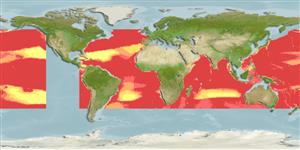Common names from other countries
>
Stomiiformes (Lightfishes and dragonfishes) >
Stomiidae (Barbeled dragonfishes) > Astronesthinae
Etymology: Heterophotus: Greek, heteros = other + Greek, photos = light (Ref. 45335).
More on authors: Regan & Trewavas.
Environment: milieu / climate zone / depth range / distribution range
Ecologia
marinhas batipelágico; intervalo de profundidade 790 - 1420 m (Ref. 58302). Deep-water; 55°N - 40°S, 85°W - 125°W
Eastern Atlantic: Western Sahara south to Namibia, not recorded close to the coast. Western Atlantic: Bermuda south to Brazil including Caribbean Sea and the southern Subtropical Convergence. Also, Indian and Pacific Oceans.
Tamanho / Peso / Idade
Maturity: Lm ? range ? - ? cm
Max length : 35.6 cm SL macho/indeterminado; (Ref. 4465)
Espinhos dorsais (total) : 0; Raios dorsais (total) : 11 - 13; Espinhos anais: 0; Raios anais : 12 - 17. Teeth on jaws very short, spine-like; photopores of ventral row excluding AC series arranged in discontinuous, close-set groups of 1 to 5 (Ref. 559). Barbel shorter than head, dark stem, flattened and tapering tip (Ref. 37473). Black in color (Ref. 37039).
Meso- and bathypelagic (Ref. 58302).
Ciclo de vida ou comportamento de acasalamento
Maturities | Reprodução | Spawnings | Egg(s) | Fecundities | Larvas
Gibbs, R.H. Jr., 1990. Astronesthidae. p. 300-307. In J.C. Quero, J.C. Hureau, C. Karrer, A. Post and L. Saldanha (eds.) Check-list of the fishes of the eastern tropical Atlantic (CLOFETA). JNICT, Lisbon; SEI, Paris and UNESCO, Paris. Vol. 1. (Ref. 4465)
Status na Lista Vermelha da UICN (Ref. 130435)
CITES (Ref. 128078)
Not Evaluated
Ameaça para os humanos
Harmless
Uso pelos humanos
Ferramentas
Relatórios especiais
Baixar XML
Fontes da internet
Estimates based on models
Preferred temperature (Ref.
115969): 3.8 - 8.2, mean 5 (based on 525 cells).
Índice de diversidade filogenética (Ref.
82804): PD
50 = 1.0000 [Uniqueness, from 0.5 = low to 2.0 = high].
Bayesian length-weight: a=0.00417 (0.00171 - 0.01014), b=3.05 (2.83 - 3.27), in cm Total Length, based on LWR estimates for this (Sub)family-body shape (Ref.
93245).
Nível Trófico (Ref.
69278): 4.2 ±0.73 se; based on food items.
Resiliência (Ref.
120179): médio(a), tempo mínimo de duplicação da população 1,4 - 4,4 anos (Preliminary K or Fecundity.).
Fishing Vulnerability (Ref.
59153): Low to moderate vulnerability (33 of 100).
